The US South Can Protect Its Water By Paying To Protect Its Forests
Clean water doesn’t come cheap. Communities and businesses often rely on expensive water filtration infrastructure to ensure their clean water supplies. But communities around the world have been protecting upstream forests instead of building new, costly water treatment infrastructure. Can this strategy work in the US south?

28 February 2011 | Water treatment is expensive business, and cities around the world – from Denver in North America to Zapalinamé in Latin America to Dar es Salaam in Africa are learning to reduce those costs by investing in the well-being of the forests that capture, filter, and deliver the water.
Each case is different, however, and such mechanisms aren’t suited to all terrains.
The World Resources Institute (WRI) has investigated this potential in the southern part of the United States, and today published its findings in “ Forests for Water: Exploring Payments for Watershed Services in the US South.” The issue brief provides an overview of how businesses and water utilities in the United States and Latin America are pursuing upstream forest conservation as a cost-effective means of ensuring clean water supplies. It also suggests how many of these approaches could be applicable in the southern United States.
Connecting Forests and Clean Water
Forests are often overlooked for the freshwater benefits they provide, but two thirds of the nation’s water comes from forested lands in the United States. This water comes from precipitation that is filtered through forests, and much of it ends up in streams. In addition to filtering and purifying water, forests naturally regulate the timing and amount of water flows, which helps lessen flooding during heavy rainstorms. Forests also help curb erosion and prevent excess nutrients from fertilizer from entering nearby bodies of water.
Businesses and communities enjoy immense economic benefits from these forest “ecosystem services”. WRI’s report cites, for example, the following:
- By naturally filtering water, forests can reduce drinking water treatment costs. For example, New York City famously saved billions of dollars in water filtration costs by conserving the forests and natural landscapes of the Catskills instead of paying for a new water filtration system.
- By curbing erosion, forests can keep sediment and excess nutrients out of waterways. For instance forest buffers near streams can prevent nitrogen from entering waterways at approximately one-third of the cost per pound of nitrogen relative to wastewater treatment plant upgrades.
- By filtering water through its porous soils, a forest can minimize wastewater treatment costs. For example, according to the Army Corps of Engineers a forest or forested wetland can filter water at approximately one-seventh of the cost per thousand gallons than can conventional wastewater treatment systems.
The Business Case for Conserving Forests for Clean Water
Public utilities, wastewater treatment plants, and governments are not the only ones that can benefit from conserving forests. Businesses that depend on a supply of clean water, such as beverage companies, power companies with hydroelectric facilities, microchip manufacturers, and housing developers may have a business case, as well.
However, these services that forests provide are threatened. In the southern United States, suburbanization has put forests, and thus the region’s clean water supply, at risk.
One innovative approach for tackling this threat is to use “payments for watershed services.” Payments for watershed services provide landowners financial incentives to conserve, sustainably manage, and/or restore forests for one or more of the kinds of watershed services mentioned above. Such payments typically involve downstream beneficiaries paying upstream forest owners or forest managers.
There are three general types of payments for watershed services that companies and governments could take advantage of to cut costs:
- voluntary payments to upstream landowners to reduce the cost of doing business;
- payments to minimize the cost of meeting a regulation; and
- payments made to generate public benefits like improved water quality.
“Payments for watershed services are a novel way to cost-effectively sustain clean water supplies while generating other benefits such as habitat conservation,” said Patricia Pineda, group vice president of philanthropy and the Toyota USA Foundation. “Innovative ideas like this one are the reason Toyota is proud to partner with WRI as part of the company’s commitment to the Clinton Global Initiative.”
From “Gray” Infrastructure to “Green” Infrastructure
Many payments for watershed services share a common trait: they are investments in “green infrastructure” instead of “gray infrastructure.” In other words, they are investments in forests and natural open space instead of in human-engineered solutions to address water quantity or quality problems.
Now that decision-makers are focusing sharply on budgets and cost-effectiveness, the time has come to see a forest for the water, not just for the trees.
To access this brief and other issue briefs in the Southern Forests for the Future Incentives Series, and to learn more about southern U.S. forests, visit: www.SeeSouthernForests.org. Developed by WRI with support from Toyota, this interactive site provides a wide range of information about southern forests, including current and historic satellite images that allow users to zoom in on areas of interest, overlay maps showing selected forest features and drivers of change, historic forest photos, and case studies of innovative approaches for sustaining forests in the region. To order free hard copies of this issue brief, and other briefs in the Southern Forests for the Future Incentives Series, please contact us.
Additional resources
Please see our Reprint Guidelines for details on republishing our articles.

